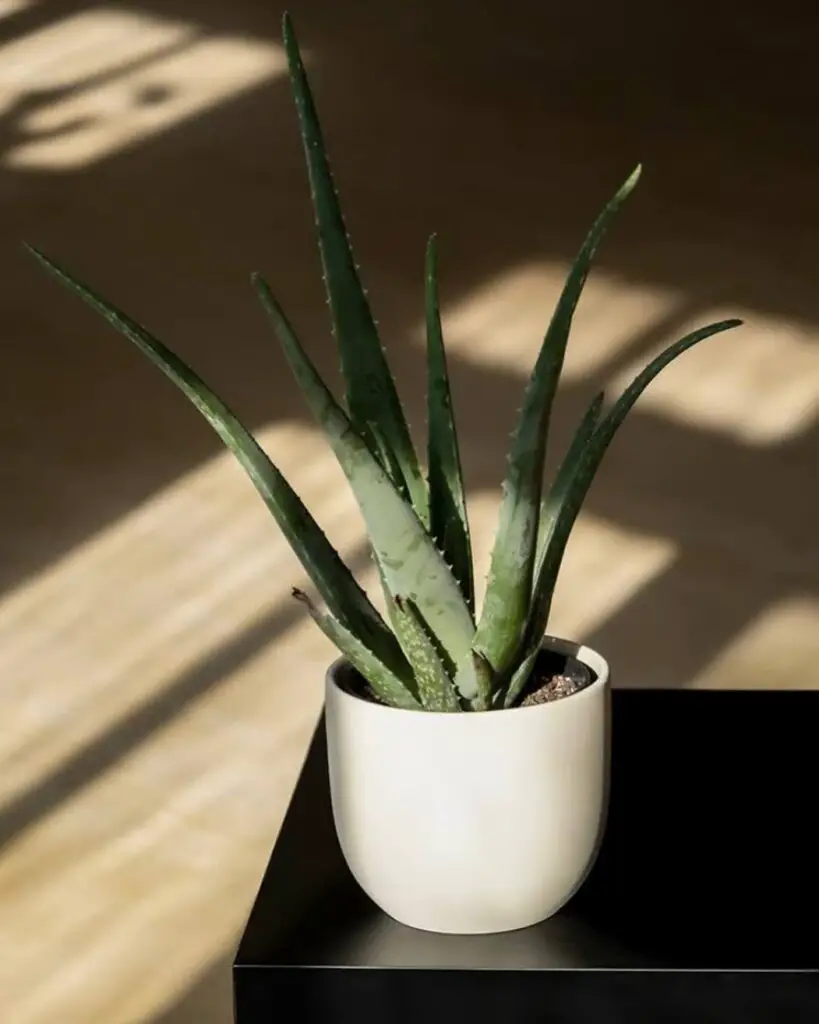Aloe vera is a popular succulent prized for its healing gel and low-maintenance nature—but how much light does an aloe vera need? Understanding its lighting needs is crucial for growing a vibrant, healthy plant indoors or outdoors. Too little light and your aloe may become leggy; too much and it might scorch.
Native to sunny, arid regions, aloe vera thrives in bright light. It prefers at least 6 hours of sunlight daily, ideally near a south- or west-facing window if grown indoors. Proper lighting ensures strong, fleshy leaves and boosts the plant’s natural healing properties. Let’s explore how to get the light balance just right.

Aloe Vera’s Native Environment Explained
To understand how much light aloe vera needs, it’s essential to look at where it naturally grows. Aloe vera originates from arid regions of the Arabian Peninsula and is now found thriving in hot, dry climates across Africa, India, and parts of the Mediterranean. These areas receive abundant sunshine, high temperatures, and minimal rainfall throughout the year.
In its natural habitat, aloe vera grows in sandy, well-draining soil under full sun exposure. The plant has evolved thick, fleshy leaves to retain water and withstand long periods of drought. This environment shapes the plant’s core requirement—consistent access to strong, direct light.
Key natural conditions of aloe vera’s native habitat:
- Full, unobstructed sun for 6–8 hours a day
- Hot daytime temperatures and cool nights
- Fast-draining, rocky or sandy soil
Understanding this helps gardeners replicate similar conditions, especially when growing aloe indoors. While it’s tolerant of some light fluctuations, keeping your aloe in a setting that mimics its natural brightness will lead to the healthiest, most robust plant. Matching its native environment is the foundation for proper aloe vera care.
Best Indoor Lighting for Aloe Vera
When growing aloe vera indoors, light is the most important factor to get right. While aloe is adaptable, it thrives best when placed in bright, direct sunlight for several hours each day. Without sufficient light, aloe vera can become leggy, pale, and weak.
The ideal spot for indoor aloe is near a south- or west-facing window. These windows receive the strongest and longest daylight exposure, which mimics the full sun conditions aloe loves. East-facing windows can work too, but may require supplemental lighting in low-light seasons or shaded homes.
Tips for proper indoor light placement:
- Place aloe 2–3 feet from a sunny window
- Rotate the pot weekly for even growth
- Avoid placing it in corners or rooms with limited natural light
If natural light isn’t enough, especially in winter, a grow light can help. Choose a full-spectrum LED or fluorescent light and place it about 6–12 inches above the plant for 12–14 hours daily. Monitoring your aloe’s appearance—such as pale leaves or slow growth—can signal when light levels need adjusting.
With consistent, bright indoor light, your aloe will maintain strong, upright leaves and continue producing its soothing gel.
Ideal Sunlight for Outdoor Aloe Vera
When grown outdoors, aloe vera loves full sun—but there are a few important nuances to consider. While it naturally thrives under intense light, too much exposure in certain climates can lead to sunburned or scorched leaves, especially during heatwaves or in young plants.
In general, aloe vera does best with 6 to 8 hours of sunlight daily. Gardeners in temperate or dry climates can safely plant aloe in spots that receive direct morning and early afternoon sun. However, in regions with extremely hot summers, a bit of afternoon shade can help protect the plant from excessive heat stress.
Best outdoor lighting practices:
- Choose a south- or west-facing spot with good air circulation
- Gradually acclimate aloe when moving it from indoors to outdoors
- Provide filtered light or shade during extreme heat or sudden temperature changes
Be mindful of leaf color changes—reddish or brownish tones often indicate sun stress. In such cases, relocate your aloe to a spot with partial shade during peak sunlight hours. When given balanced outdoor light, aloe vera develops thick, vibrant green leaves and grows vigorously with minimal care.
Recognizing Aloe Vera Light Stress
While aloe vera loves sunlight, there is such a thing as too much of it. Overexposure to intense sunlight—especially in hot climates or under midday rays—can cause visible stress to the plant. Spotting these signs early helps prevent long-term damage and keeps your aloe healthy.
Common symptoms of too much light:
- Brown or reddish leaf tips or edges
- Bleached or faded leaf color
- Wrinkled or sunken leaves despite regular watering
Sunburned aloe often displays dry, crisp patches that look white or brown, usually on the parts of the leaves facing the sun. This happens when the plant’s surface tissue gets scorched, which can slow growth or cause sections of the leaf to die off. While mature plants tolerate sun better, younger or recently repotted aloes are more vulnerable.
What to do if you see these signs:
- Move the plant to a spot with partial shade or filtered light
- Water gently and avoid fertilizing until it recovers
- Trim off severely damaged leaves if necessary
Even sun-loving succulents need protection under extreme conditions. Providing balanced lighting will help aloe vera thrive without stressing the plant.
Symptoms of Inadequate Light in Aloe Vera
Aloe vera may be low-maintenance, but insufficient light can lead to several noticeable problems. Since light is essential for photosynthesis and healthy growth, aloe plants respond quickly when they aren’t getting enough of it.
Key signs your aloe isn’t receiving enough light include:
- Stretched or leggy growth (etiolation)
- Pale or yellowing leaves
- Leaves bending or drooping toward the light source
Etiolation is one of the most common symptoms. The plant stretches unnaturally tall and thin, with long spaces between leaves, in an effort to reach more light. This results in a weak structure and a distorted appearance. Pale, washed-out leaf color also suggests the plant isn’t producing enough chlorophyll due to low light levels.
If your aloe is leaning heavily toward a window or looks flattened rather than upright, it’s likely trying to compensate for poor light positioning. In these cases, it’s best to:
- Move the plant closer to a bright window
- Rotate it regularly to prevent leaning
- Consider supplemental lighting if natural light is limited
Correcting light exposure early helps aloe vera regain its compact form and vibrant color, restoring its overall health and appearance.
How Seasonal Light Affects Aloe Vera
Aloe vera’s light requirements don’t change, but the availability of light shifts with the seasons. These seasonal fluctuations can affect growth patterns, leaf health, and overall plant vitality—especially for aloe grown indoors.
In spring and summer, longer days and stronger sunlight naturally benefit aloe vera. The plant enters an active growth phase and may produce offsets or thicker leaves. During this time, aloe thrives with at least 6–8 hours of bright light daily, preferably direct sunlight.
However, autumn and winter bring shorter daylight hours and lower sun angles. This can lead to:
- Slowed or dormant growth
- Stretching toward available light sources
- Pale or weakened foliage
To adjust for seasonal changes:
- Move indoor aloe to the brightest available window (south-facing is best)
- Supplement with grow lights for 10–14 hours per day during low-light months
- Avoid overwatering, as reduced light slows moisture uptake
Even though aloe vera remains hardy year-round, proactive light adjustments help prevent winter stress and keep the plant thriving through seasonal transitions. Keeping a close eye on light levels ensures aloe stays strong and compact regardless of the time of year.
Using Artificial Light for Aloe Vera Growth
Artificial light can play a vital role in keeping aloe vera healthy, especially in spaces with limited natural sunlight. Whether you’re growing aloe in a dark room, during winter months, or in areas with overcast weather, the right artificial lighting can effectively supplement or even replace sunlight.
Aloe vera needs bright, direct light for 6–8 hours daily. When natural light isn’t enough, full-spectrum grow lights are the best alternative. These lights mimic the sun’s spectrum and support photosynthesis and normal plant development. LED grow lights are energy-efficient and stay cool, making them ideal for home use.
Tips for using artificial light:
- Use full-spectrum LED or fluorescent grow lights
- Position the light 6–12 inches above the plant
- Run the light for 12–14 hours a day for optimal exposure
Ensure the light isn’t too close to avoid leaf burn, and check your aloe weekly for signs of light stress or improvement. If the plant perks up, darkens in color, and grows upright, your lighting setup is likely working well. Artificial lighting is especially helpful in keeping indoor aloe vibrant when natural conditions fall short.
Setting Up the Right Indoor Conditions
Creating the perfect indoor environment for aloe vera involves more than just sunlight. Temperature, airflow, container type, and humidity all play essential roles in keeping the plant healthy and vibrant indoors. Aloe may be low-maintenance, but it thrives best when its natural desert-like conditions are thoughtfully recreated.
Start with location. Aloe vera prefers a bright, sunny spot with good airflow. A south- or west-facing windowsill is ideal. Avoid overly humid rooms like bathrooms or spaces near heat vents or air conditioners, as sudden temperature shifts and high moisture can lead to root rot or fungal issues.
Indoor environment checklist:
- Temperature: Keep between 60–75°F (15–24°C)
- Humidity: Low to moderate; avoid humid spaces
- Air circulation: Ensure gentle airflow; open windows occasionally
- Pot & soil: Use terra cotta or clay pots with drainage holes and cactus/succulent soil
Also, resist the urge to overwater. Aloe vera stores moisture in its leaves and needs to dry out between waterings. Water sparingly—typically every 2–3 weeks, depending on indoor climate. By balancing light with proper temperature and airflow, you can create an ideal indoor setting where aloe vera thrives year-round.
Final Thoughts
Aloe vera requires consistent access to bright, direct light for healthy growth. Whether growing indoors or outdoors, ensuring your plant gets the right amount of light—along with proper temperature, humidity, and care—will help it flourish. By adjusting to seasonal changes and supplementing with artificial light when needed, you can enjoy a vibrant, thriving aloe vera plant year-round.

I’m Shofi, a passionate gardener and blogger. I have 10+ years of experience in gardening and hold certifications in horticulture and garden design. I share my knowledge and skills through my garden blog to inspire and educate others on the joys of gardening. I try to provide valuable information and create a community for gardeners of all levels to connect and learn. My ultimate goal is to inspire others to start their own gardens and connect with nature.

